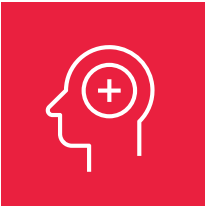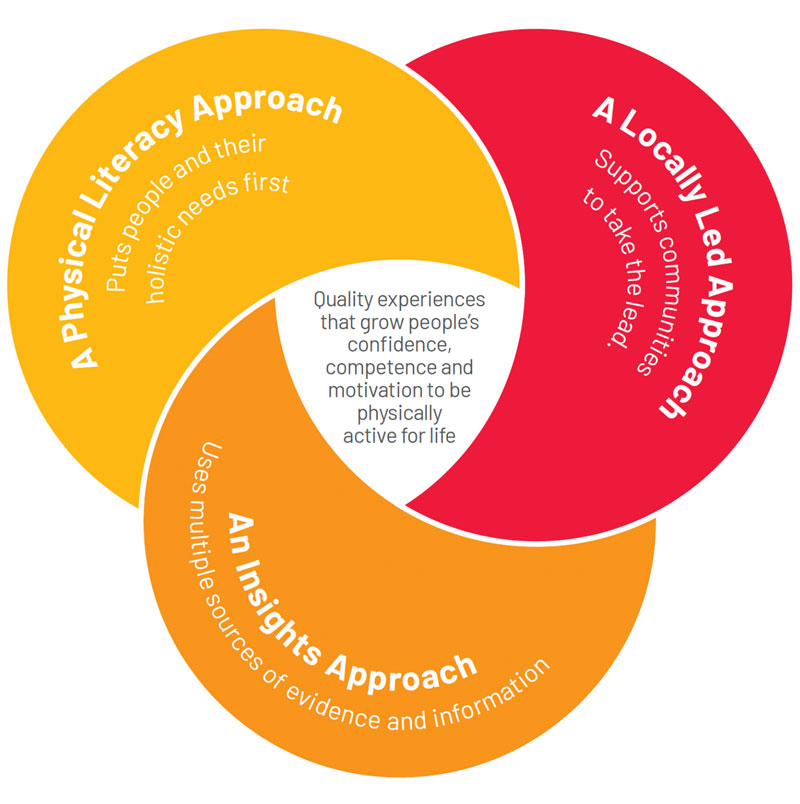Three Approaches
Three Approaches
Creating better quality experiences for participants

We know from our Value of Sport research that, participation in play, active recreation, and sport support wellbeing. We also know that to reap the full benefits of physical activity, people need quality experiences that increase their confidence, competence and motivation to value and choose active lifestyles.
Sport New Zealand’s role as a kaitiaki of the play, active recreation and sport system focusses on lifting the physical activity levels of all those living in Aotearoa New Zealand. In doing this, we believe we will have the greatest impact on wellbeing.
Within our 2015-20 strategy we promoted the Three Approaches: the importance of using evidence, community input, and a holistic approach to create a better quality experiences for participants. We now know that working this way is guiding better decision making and supporting organisations to have a greater impact on the system. That’s why they remain the foundation of our 2020-24 strategic plan.
Sport NZ’s three main approaches for working with people and communities to create these quality experiences are:
This webpage explains these approaches and how they can be used to drive meaningful and positive change.
Insights and Evaluation Approach
- Uses multiple sources of information (big picture data, local knowledge and the voice of the participant) in your context, to better understand the needs of participants and to guide decision making.
- Encourages ongoing evaluation and continuous feedback to enable improvement and ensure initiatives continue to meet participants’ needs.
Locally Led Approach
- Seeks to learn from what is strong and positive.
- It’s about working in partnership with communities, organisations, schools/kura and groups towards goals, aspirations and opportunities identified by them.
- Solutions are co-created for positive change.
Physical Literacy Approach
- Promotes the contribution being active has to overall wellbeing.
- Is about supporting people to value and choose physical activity (in a way that meets their needs) throughout their lives.
- Focusses on fostering ongoing motivation, confidence, competence to be active, along with developing the knowledge and understanding of what value being active can have.
- Requires us to consider the quality of the support, opportunities, and experiences we design, facilitate and deliver. These need to recognise and respond in a holistic way, involving the physical, social, emotional, cognitive and spiritual dimensions of people.
Many organisations within the sector have already demonstrated the benefit of using the Three Approaches together. Case studies illustrating how to develop quality experiences for participants can be found here.
Questions to consider when using the three approaches
We have developed the following questions to consider when thinking about how to use the Three Approaches. The terminology, language used, and how it ‘looks on the ground’, should reflect the people and groups you’re working with.
-
1. Where should you start?
How will you identify and prioritise your audience?
Critical questions to consider
- Who are the people we want to work with and why (consider age, gender, location, participation)?
- What is our baseline (who’s participating now), and do we have a clearly defined objective or idea of what success looks like?
- How we do ensure the people have input into what success looks like for themselves at all stages? E.g. planning, delivery, and evaluation.
- What parameters will we use to determine where we should work (e.g. participation numbers, demographic groups, the greatest impact, inequalities)?
Ideas to get you started
- What are the most valuable resources, strengths and assets we have available? Map the answers to generate the foundations of a plan.
- Check out existing data sources for information specific to your context including:
-
2. How can you seek to understand?
Taking the time to develop a deeper understanding will influence how you shape your activity.
Critical questions to consider
- What information, local knowledge and voice of the participant can we access to develop a better understanding of the people you want to work with?
- What is already working well and how can we build on this?
- What other activities exist in our local areas that cater for this community?
- What existing or new networks can we connect with to contribute to our understanding?
Ideas to get you started
- Identify other organisations, groups or agencies that are working in this space and speak with them (this doesn’t have to be other sport and recreation organisations).
- Identify other similar initiatives across the sector and talk to the people involved. Ask targeted questions to understand what, why and how these have been successful.
- Conduct a web search of similar activities with similar groups.
-
3. How to understand strengths/needs of people you work with
Taking the time to understand the needs of your target audience will support the development of a quality participant experience.
Critical questions to consider
- What effects people’s participation choices? Consider physical, social, emotional, cognitive and spiritual dimensions.
- How can we focus on building more than skills, and support ongoing motivation, confidence and the wider value of physical activity?
- What will we do to engage people to co-design and implement experiences alongside them?•What developmental life-stage information may be relevant to consider?
- Will those providing support be knowledgeable, principled, encouraging and relevant to those participating?
- Will the opportunities available be accessible for all, safe and emphasise reducing participation barriers?
- Will the experience positively affect how the participant values physical activity and impact positively on all elements of wellbeing?
Ideas to get you started
- Check out the holistic approaches here.
- Learn from other agencies that work with the people you will be working with; can you share existing data?
- Learn more about what child centred means in practice.
- Create opportunities to talk directly with the people you will be working with, for example:
- Focus groups in targeted settings (eg schools, youth groups or churches, community interest groups, local shopping area)
- Keen youth willing to ‘survey’ their peers about their needs, wants, motivators
- Post questions on the Facebook page of a local community group. Find out what matters to the people you wish to work.
-
4. Has the activity been implemented as intended?
Constant reflection, learning and adaptation are necessary to ensure a participant focus is maintained and opportunities remain relevant.
Critical questions to consider
- Is the activity being delivered as originally planned? Was it done well? Did we allow for authentic co-design?
- What feedback and discussion loops can we build into the initiative to help us understand and change our practice?
- Are we on track to achieve the shared objectives we co-created?
- What’s working well, what’s not and why?
Ideas to get you started
Check out: ‘Making sense of evaluation: A handbook for everyone’
- Develop a logic model to explain how your programme will work.
- Get the best possible insight through combining multiple sources of information (both qualitative and quantitative).
Examples of how you might do this are:
- Using registration forms to track attendance and other useful baseline details relating to your objectives
- Seeking formal and informal feedback from participants and activity leaders at various stages, for example, paper-based or online feedback forms or informal conversations
- Tracking progress financially against budgets or targets.
-
5. How do you know if you're making a difference?
Outcome evaluation enables you to assess if the activity achieved the changes you wanted to see.
Be practical – identify a small number of questions that are most useful for determining the effectiveness of your initiative and feasible to answer.
Critical questions to consider
- Do we have a clearly defined objective or idea of what success looks like? Are the changes we are seeing attributable to the initiative? Find out using the Insights and Evaluation Approach Maturity Model.
- Is your organisation putting people and their needs and choices at the centre of any decision-making? Are the experiences being designed, facilitated and delivered supporting overall wellbeing? Are they motivating people to keep choosing active lifestyles? Find out using the Physical Literacy Approach Maturity Model.
- Are you working in partnership with your communities, organisations, schools/kura towards their goals, aspirations and the opportunities they want? Find out using the Locally Led Approach Maturity Model.
Using the Three Approaches, Insights, Locally Led and Physical Literacy, together provides you with a powerful planning tool. It is also an effective way to enhance relationships and better respond to the identified needs of communities, and to deliver better quality experiences that will have a positive impact on participation.
For further information on the Three Approaches, please contact your local Regional Sports Trust.
Find out in more detail about each of the approaches and how you can embed them to see positive results in your community.
Locally Led Approach
Working in partnership with your communities, organisations, schools/kura and population groups towards their goals, aspirations and opportunities for positive change. The Locally Led Approach aims to challenge inequities and work more closely with communities facing barriers to being physically active.
Physical Literacy Approach
By focusing first on people's needs in a holistic way, our planning and decision making can emphasise and foster ongoing motivation, confidence and competence. It also helps to develop the knowledge and understanding about the wider value that being active has for people and communities.
Insights Approach
Using multiple sources of information within the context you are working in, to help you understand the needs of participants and improve decision-making. Evaluation should be an integral part of the development and implementation of any initiative to ensure you meet the needs of participants.

